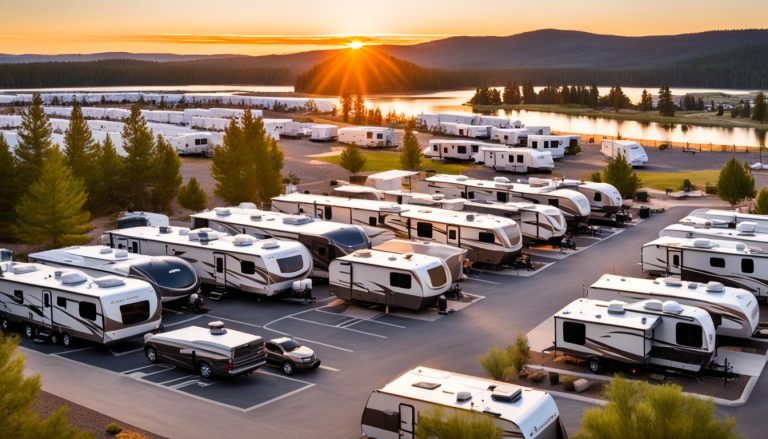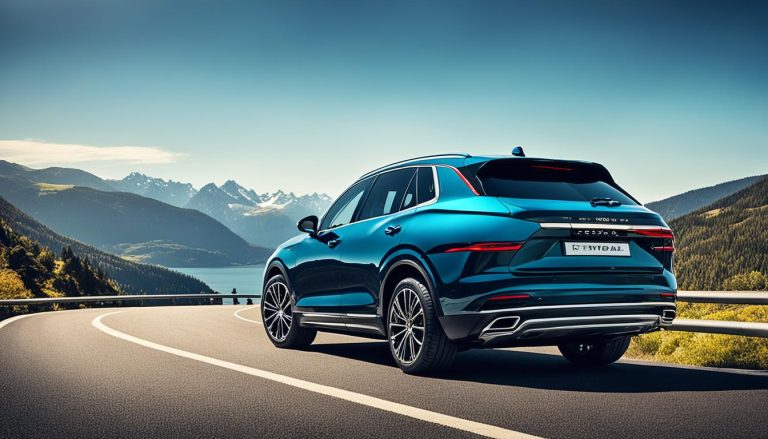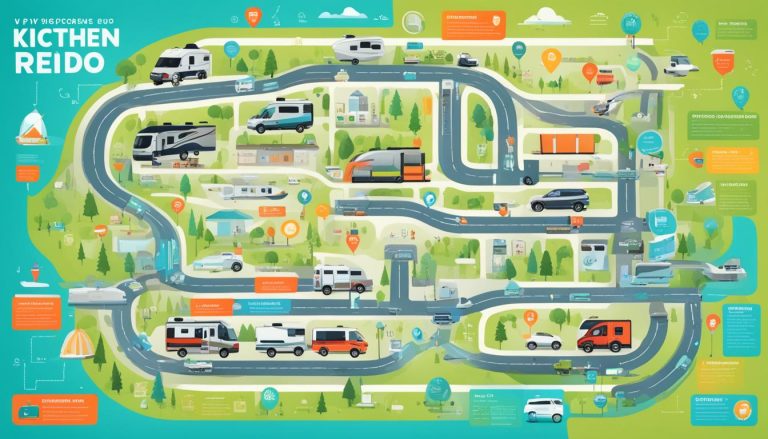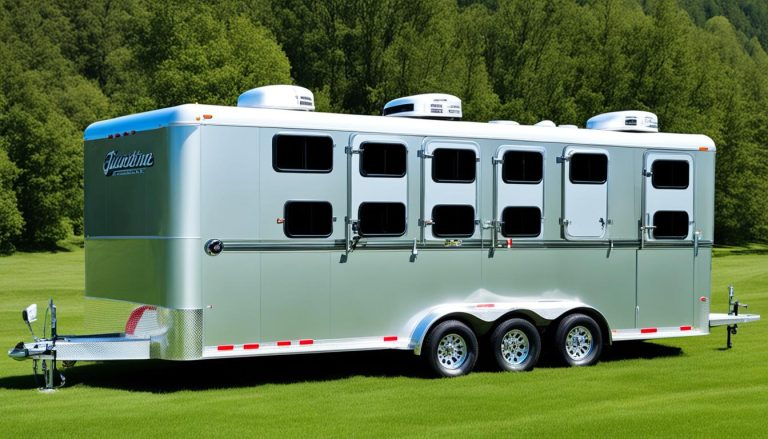Find Your Ideal RV for Occupants & Sleep Needs
gorvlifestyle.com and its partners may earn a commission if you purchase a product through one of our links
Selecting the perfect RV for your explorations begins with understanding how to meet the comforts of each traveler. Whether you’re planning solo journeys or family excursions, choosing the right RV is paramount for a successful trip. Family RV options vary as much as families themselves, making it vital to assess each model for its unique qualities.
Before setting off into the great outdoors, one must consider the RV size for sleeping and the lifestyles it will accommodate. From cozy campers to spacious motorhomes, the quest for the optimal dwelling on wheels hinges on aligning the vehicle’s amenities with each adventurer’s needs. Hence, the journey towards a treasured home on the road unfolds with a clear vision for nightly rest and daytime delights.
Key Takeaways
- Understanding individual sleep needs is a catalyst for choosing the right RV.
- Considering RV size for sleeping is essential for on-the-road comfort and convenience.
- Exploring Family RV options ensures a fit for all family members’ needs.
- Evaluating an RV’s layout and amenities contributes to better travel planning.
- Selecting an RV isn’t just about size; it’s about matching lifestyle and travel aspirations.
Understanding RV Size and Capacity for Your Family
Embarking on an RV journey is an exciting adventure that requires meticulous planning, especially when considering the number of occupants and the RV size for sleeping. The intricate balance of family size, travel plans, and RV sleeping arrangements must be navigated to ensure a comfortable and memorable experience. Finding the best RV for large families, or even for a smaller group, relies on recognizing both immediate and future needs adhering to the ever-important RV sleeping capacity.
Assessing Family Size, Travel, and Sleeping Arrangements
The selection of an RV is deeply personal, and it should suit the unique characteristics of each family. A family with children, for instance, might prioritize different features compared to a travelling couple. Whether it’s a long vacation or a permanent shift to mobile living, understanding the practicality of space, privacy, and adaptability in sleeping solutions is paramount.
Evaluating RV Length for Full-time vs. Occasional Use
For those who dream of the nomadic lifestyle, choosing a vehicle that can serve as a full-time home is crucial. With more extensive travel itineraries and longer periods of habitation, a larger RV equipped with a full suite of amenities can transform from a mere vehicle into a home on wheels. Conversely, occasional RVers may value simplicity and mobility, adopting a smaller model that provides the essence of RV living without the bulk. Below is a comparative table to better understand the various RV sizes and their capacity for sleeping arrangements.
| RV Type | Length (ft) | Sleeping Capacity | Best Usage |
|---|---|---|---|
| Class A Motorhome | 29 – 40 | 4 – 8 | Full-time luxury and space |
| Fifth Wheel | 22 – 40 | 6 – 9 | Family and long-term travel |
| Travel Trailer | 10 – 40 | 4 – 10 | Versatile use, balanced option |
| Class C Motorhome | 21 – 35 | 4 – 8 | Combination of comfort and maneuverability |
| Class B Camper Van | 16 – 22 | 2 – 4 | Ideal for couples and solo adventurers |
| Pop-Up Camper | 8 – 16 | 2 – 6 | Occasional camping, reconnecting with nature |
Choosing the right RV based on the number of occupants and sleeping needs
Embarking on an RV journey brings the promise of adventure, but the success of your travels often hinges on choosing the right RV that meets your sleeping needs and accommodates your party size. Comfort becomes paramount when selecting your home on wheels. A practical step is to envision the RV as both a vehicle for exploration and a sanctuary for rest, ensuring each occupant has their personal haven for rejuvenation after a day full of activities.
An RV that addresses your family RV options with versatility can be a game-changer. Whether you’re hitting the road with a partner or embarking on a cross-country trip with kids in tow, the layout and sleeping configurations can make or break the experience. Here’s a closer look at how to align your choice with your lifestyle:
- Fixed Beds: Ideal for couples or small families preferring a ready-made sleeping area without additional setup.
- Bunk Beds: A space-saver for families, offering individual sleeping quarters that children love.
- Fold-Outs and Convertibles: Great for accommodating guests and providing flexibility in how you use your space during the day versus night.
A detailed consideration of the various sleeping arrangements within an RV lends invaluable perspective on not just the quantity but also the quality of the accommodations within your rolling residence.
| Type of RV | Total Sleeping Capacity | Type of Sleeping Arrangements | Best Suited For |
|---|---|---|---|
| Class A Motorhome | 4-8 | Master bed, Convertible sofas, Drop-down bunks | Large families or full-time RVers |
| Travel Trailer | 2-6 | Fixed bed, dinette bed, bunk beds | Small families or occasional vacationers |
| Fifth-Wheel | 6-10 | Master suite, Bunkhouse, Convertible dinettes | Extended families with a need for space and comfort |
| Class B Campervan | 2-4 | Convertible bed, fold-out panels | Solo adventurers or couples |
| Class C Motorhome | 4-8 | Over cab bunk, Master bed, convertible spaces | Families seeking a balance of mobility and comfort |
With the various configurations available, selecting an RV that caters to sleeping needs becomes less about overwhelming options and more about pinpointing the layout that feels like home. Whether you’re looking for fixed beds for hassle-free rest or convertible spaces for entertaining and sleeping, it’s the ‘right fit’ that ultimately turns an RV from a vehicle into a cherished part of the family’s history.
The Pros and Cons of Different RV Types for Sleeping Comfort
When deliberating over the various RV types available on the market, one of the most crucial aspects to consider is the RV sleeping capacity and RV sleeping configurations. Depending on the model, each RV can greatly differ in the comfort and space it provides for sleeping. Drivable RVs, such as Class A, B, and C motorhomes, deliver ease of mobility and convenience, allowing travelers to comfortably access their necessities while on the move. On the other hand, towable RVs like fifth wheels and travel trailers offer more expansive interiors, making them a popular choice for those who stay at a single location for prolonged periods.
The following table outlines the primary advantages and disadvantages of these RV types with respect to sleeping comfort. Whether considering a full-time residence or a vacation home on wheels, discerning between these features can help make a more informed decision that will enhance your traveling lifestyle.
| RV Type | Advantages | Disadvantages |
|---|---|---|
| Drivable RVs (Class A, B, C) |
|
|
| Towable RVs (Fifth Wheels, Travel Trailers) |
|
|
Understanding the nuances between different RV sleeping configurations can also significantly impact your decision-making process. For instance, some RVs feature fixed beds in dedicated sleeping quarters, while others offer convertible dinettes or drop-down beds that serve dual purposes. These considerations go hand in hand with the RV sleeping capacity, dictating how many individuals can comfortably rest during the journey.
In summary, selecting the right RV is about balancing your travel habits, space requirements, and the level of comfort you desire. Taking into account the advantages and disadvantages of each RV type will ensure you find a sleeping setup that aligns with your lifestyle and permits you to wake up refreshed, ready for the day’s adventures.
Key Considerations for RV Sleeping Arrangements
When it comes to maximizing comfort and utility in an RV, sleeping arrangements are a pivotal aspect. For those venturing into the world of recreational vehicles, understanding the various configurations and options available can be crucial in selecting the best RV for their needs, whether it’s accommodating large families or ensuring adaptable sleeping spaces.
Importance of Configurable Sleeping Spaces
Configurable sleeping spaces are a game-changer in the realm of RV travel, especially when it comes to balancing daytime activities with a restful night’s sleep. RV sleeping configurations are designed to offer flexibility, allowing owners to easily switch between living and sleeping areas. For example, the dining area, typically a dinette, can be transformed into additional sleeping quarters as needed. This versatility is particularly beneficial for those who may occasionally host guests or require extra sleeping space without committing to a larger, more permanent sleeping area.
Privacy and Separate Sleeping Areas for Larger Families
For larger families or groups prioritizing comfort and personal space, the RV sleeping capacity becomes even more critical. As one of the best RVs for large families are those with distinct sleeping areas, such as separate bedrooms and bunkhouses, which allow for a higher level of privacy and individual space. This is essential not only for nightly comfort but also for ensuring that each member of the family can maintain personal routines and habits while on extended trips.
| RV Type | Typical Sleeping Arrangements | Privacy Level | Best Use Scenario |
|---|---|---|---|
| Class A Motorhome | Master bedroom, Convertible sofas, Drop-down bunks | High | Large families, Long-term travel |
| Fifth-Wheel | Separate bunk room, Master suite, Pull-out couches | High | Extended stays, Extra comfort |
| Travel Trailer | Dinette beds, Murphy beds, Double bunks | Medium | Occasional travel, Weekend outings |
In essence, the RV sleeping arrangements must be carefully considered to ensure they align with the user’s lifestyle and travel needs. Customizable and separate sleeping solutions provide the versatility and privacy required for a harmonious journey, establishing the foundation for unforgettable RV experiences.
Common Mistakes to Avoid When Selecting an RV
Embarking on the journey of choosing the right RV is filled with exciting possibilities but also potential pitfalls. One of the key missteps individuals encounter is being swayed by the allure of the largest, most feature-packed RV on the lot. While it’s tempting to equate size with comfort, many fail to consider whether such a behemoth aligns with their travel itinerary, especially when it includes destinations with vehicle size restrictions like national parks.
The ideal RV size for sleeping and comfort may not always be the biggest one available. This is especially true when the RV is intended for more than just camping – when it needs to serve as a practical vehicle for day-to-day activities or navigate through tight campground spots. Therefore, evaluating the ease of driving and towing your prospective mobile abode is paramount.
When aspiring RV owners overlook the reality of their travel goals and driving comfort, they may find themselves with an RV that is more of a burden than a retreat. To prevent this, it’s important to ask oneself key questions: Will I feel confident driving a larger rig? Do my preferred destinations have size limitations? What’s the balance between my need for space and the convenience of maneuverability?
Here’s a succinct overview of what to consider:
- Assess your travel destinations for any vehicle size restrictions.
- Evaluate your comfort level with driving or towing larger units.
- Consider how often the RV will be used for daily commutes or errands.
- Identify the essential features you need to enjoy the RV lifestyle.
By avoiding the trap of “bigger is better” and focusing on practicality, adventurers can ensure their RV not only accommodates a peaceful night’s sleep but also complements their travel dreams and abilities.
RV Size Limitations: What You Need to Know
Embarking on an RV journey necessitates a deep understanding of various size restrictions that could affect your travel plans. Navigating through the regulations and individual campground rules is pivotal for seamless RV adventures. RV size limitations are not merely a matter of preference; they are often dictated by legal requirements and can vary significantly from state to state. Drawing awareness to these limitations is essential, particularly when planning to explore diverse destinations or when your journey involves staying at multiple campgrounds.

Legal Restrictions and Height, Length, Width Considerations
As you delve into the exciting world of RV travels, it’s crucial to acknowledge the legal boundaries that define RV size. Each state may impose its own set of height, length, and width standards that ensure the safety of not only those inside the RV but also other road users. Complying with these measures is necessary to prevent any unwelcome surprises during vehicle inspections or when encountering restrictive infrastructure such as bridges or tunnels. These dimensions directly influence RV sleeping configurations and the number of occupants an RV can legally support.
Navigating Campground RV Size Restrictions
Finding the perfect spot to rest and recharge is an integral part of the RV experience. However, prospective RV owners must take into account that many campgrounds have their own set of size restrictions to accommodate a diverse range of visitors. These limitations can greatly impact both where you can stay and the RV sleeping arrangements available to travelers. To avoid potential issues, it’s advisable to research the specifics of the campgrounds you wish to visit in advance, ensuring your RV fits within the accepted size parameters. With thoughtful planning, you can ensure your RV brings about the comfort and adaptability needed for every escapade.
Best RV for Large Families and Group Travel
Exploring the great outdoors with a large family or a group can transform an ordinary vacation into a lifetime of cherished memories. To ensure that everyone has a comfortable place to rest, discerning the best RV for large families becomes a pivotal decision. These recreational vehicles must possess the RV sleeping capacity to house each member comfortably, paired with versatile areas capable of offering both shared and private spaces.
Sizable fifth-wheel campers and extensive Class A motorhomes rank at the top for families prioritizing space and privacy. With their expansive floor plans, these RVs address the need for separate sleeping quarters while still offering generous communal areas for group activities and socializing.
The key features that make fifth-wheels and Class A motorhomes particularly appealing are:
- Master bedrooms with queen or king-sized beds
- Bunkhouses that can double as daytime play or study areas
- Convertible dinettes and sofas, maximizing the use of living space
- Slides that extend to provide additional square footage
Families adventuring together will find the multi-use nature of these RVs allows them to balance the dynamics of travel and rest flawlessly. With enough room to accommodate personal downtime or group gatherings, such RVs envelop large families in the comfort and functionality needed to create a home away from home.
How to Determine Your RV’s Sleeping Capacity
For RV enthusiasts who are pondering their next adventure, understanding the RV sleeping arrangements and RV sleeping capacity is paramount. The layout of your recreational vehicle dictates both comfort and capacity, influencing your experiences on the road. Whether you journey occasionally or live in your RV full-time, the ability to identify each potential sleeping area can make a considerable difference in your travels.
To ensure a relaxing journey, consider this guide on enumerating and evaluating the sleeping quarters within your RV:
- Begin by visually inspecting the RV’s interior and pinpoint the master beds, which are usually fixed and offer the primary sleeping space.
- Note the number of convertible couches that can transform into beds, acknowledging their size and suitability for adults or children.
- Examine the dinettes that can be converted for nighttime use, often ideal for younger RVers or single adults.
- Account for the presence of bunk beds, a popular choice in family-friendly models, providing dedicated spaces for additional sleepers.
When assessing the overall sleeping capacity, it’s not just the quantity but also the quality that matters. Comfortable mattresses and privacy options are essential considerations, particularly for those who spend significant time on the road. Customization is another factor to think about, as it affords the flexibility to modify sleeping arrangements to fit each traveller’s needs uniquely.
| Type of Sleeping Area | Typical Capacity | Best Suited For |
|---|---|---|
| Master Beds | 2 Adults | Full-time couples |
| Convertible Couches | 1 Adult or 2 Children | Guests or children |
| Dinettes | 1 Adult or 2 Children | Temporary sleeping space |
| Bunk Beds | 1 Person per bunk | Children or solo travelers |
Remember, the aim is to ensure that every traveler has a personal space to retreat to at the day’s end. It’s about striking a balance between maximizing space and maintaining the serenity that a good night’s sleep offers. With careful planning and strategic layout evaluation, you can achieve an optimal RV sleeping arrangement that accommodates everyone’s needs.
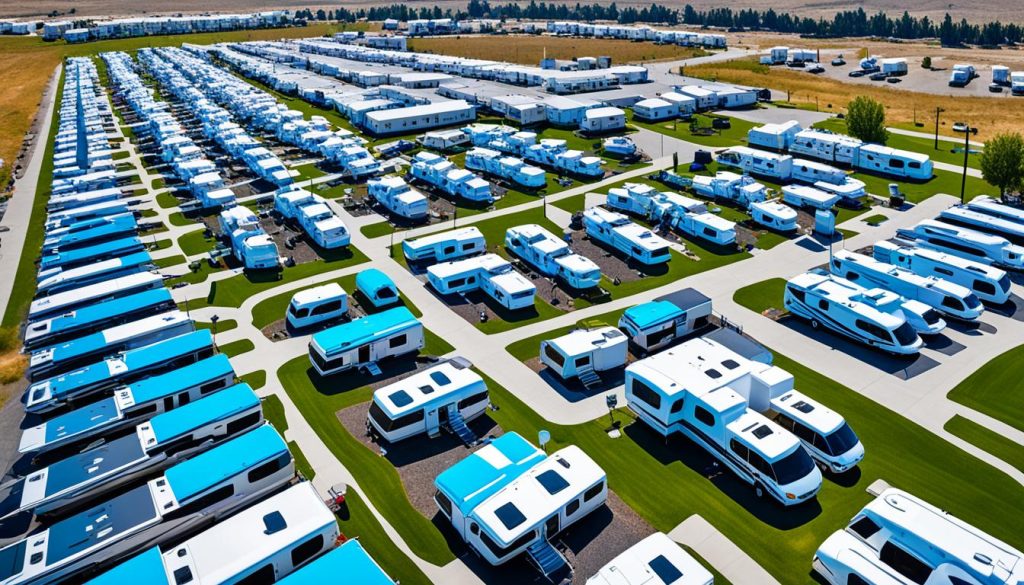
In conclusion, take the time to truly map out the sleeping options available in your prospective or existing RV. Doing so will not only enhance your rest while traversing the landscapes but ensure that your adventures on the road are as comfortable as they are memorable.
Optimizing for Comfort: RV Sleeping Configurations Explained
When embarking on an RV adventure, the quality of one’s sleep can be just as important as the destination itself. To turn a rolling home into a sanctuary of rest, travelers must consider the various RV sleeping configurations available. Some configurations prioritize maximum space efficiency, while others focus on comfort, resembling the sleeping arrangements of a traditional home. An insightful look into the diversity of these setups can aid travelers in identifying the perfect RV sleeping arrangements to meet their specific travel and comfort needs.
Stationary beds provide the comfort of a traditional sleep setting and are ideal for those who do not wish to convert their sleeping space daily. On the other hand, modern RVs have ingeniously incorporated Murphy beds and fold-down bunk beds to provide both functionality during the day and comfortable sleeping quarters at night. Such multipurpose configurations make efficient use of the limited space available within an RV.
To illustrate the breadth of RV sleeping arrangements, let’s look at a comparative table that provides a snapshot of common configurations:
| Sleeping Configuration | Description | Ideal For |
|---|---|---|
| Fixed Master Bed | A permanently set bed, often queen-sized or larger, situated in a dedicated sleeping area. | Long-term travelers seeking a home-like bedroom. |
| Convertible Dinette | A dining area by day that transforms into a sleeping space at night. | Occasional travelers and families needing flexible space. |
| Drop-Down Beds | Beds that lower from the ceiling, providing extra sleeping space without permanent allocation. | Those looking to maximize living areas when beds are not in use. |
| Bunkhouse | A separate room containing bunk beds, commonly found in larger RVs or fifth wheels. | Large families or groups requiring additional private sleeping quarters. |
| Murphy Bed | A wall-mounted bed that folds up during the day, revealing a sofa or desk area. | Solo travelers or couples who value multipurpose living spaces. |
Selecting the right RV sleeping configuration is not just a matter of personal preference; it is a strategic decision that impacts the overall RV experience. As such, RV enthusiasts must weigh their options thoroughly, considering factors such as the number of travelers, lifestyle, and the balance between wakeful living and restful slumber.
A well-planned RV sleeping arrangement becomes not only a place to lay one’s head but a personal retreat after a day of exploration. Whether it’s a cozy corner for a peaceful siesta or a spacious bed to stretch out under the stars, each configuration has its unique charm and functionality, ensuring that every nomad can find their haven on wheels.
Balancing Budget and Needs in Your RV Choice
Choosing the ideal RV goes beyond just the number of beds and the layout. When considering an RV size for sleeping comfortably, or identifying the best family RV options, the financial implications are a significant factor. Understanding the true cost of ownership and additional RV expenses will create a balance between fulfilling travel desires and managing financial responsibilities.
The True Cost of Owning Different RV Sizes
RVs designed to improve RV sleeping capacity and offer comfort for the entire family inevitably come with increased costs. Price tags extend beyond the initial purchase, enveloping a myriad of ongoing expenses. Storage fees, for instance, might be heftier for larger RVs, while insurance premiums could take up a notable part of the budget. Recognizing these costs early on helps in planning a sustainable RV lifestyle that doesn’t strain financial resources over time.
Additional Expenses to Anticipate in RV Ownership
Securing an RV comes with a list of necessary add-ons that ensure functionality and convenience. Prospective RVers need to budget for the upfront costs of towing equipment and operational gadgets. Furnishings for a comfortable living experience, both inside and out, should also be considered. The table below offers a snapshot of recurring expenses that accompany RV ownership, helping you anticipate and plan for the additional costs effectively.
| Expense | Smaller RVs | Larger RVs |
|---|---|---|
| Insurance | More economical | Higher premiums |
| Storage | Possible home storage | Professional storage fees |
| Maintenance | Less complex systems | More extensive maintenance |
| Fuel | Generally more fuel-efficient | Increased fuel consumption |
| Campground Fees | More site options, often less expensive | Higher fees, fewer options |
| Additional Equipment | Less equipment needed | Heavier investment in gear |
With this comprehensive understanding of the costs related to the RV sleeping capacity and family RV options, future RV owners can make more informed decisions that align with their budget and adventuring needs.
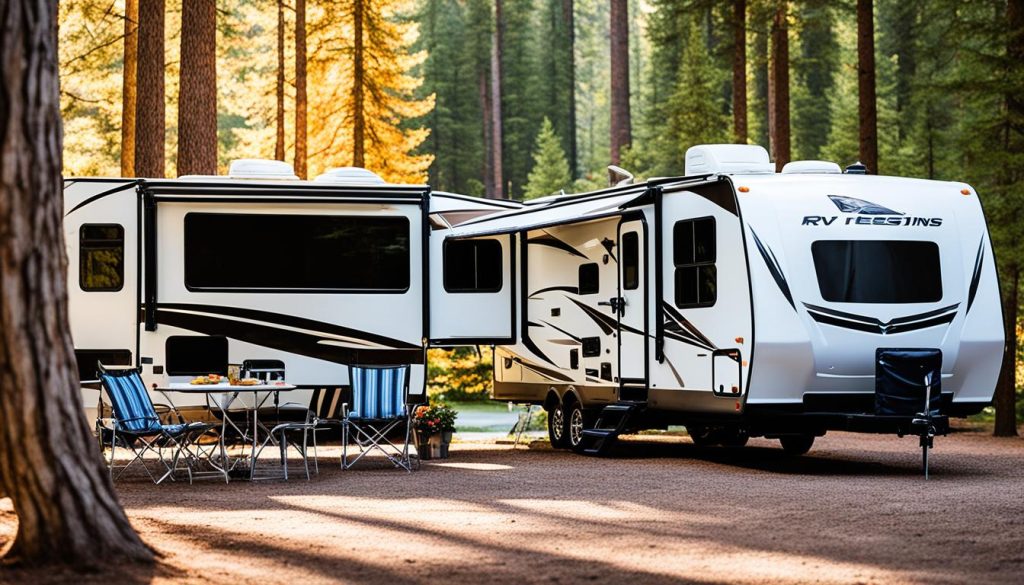
Test Driving Your RV Lifestyle Before Purchase
Embarking on the journey to choose the right RV for your family’s needs takes more than just research; it involves getting hands-on experience. Trial runs in the form of renting an RV can offer potential buyers a real-world preview into what life on the road entails. For families or groups considering an RV with sufficient sleeping needs and living spaces, experiencing firsthand how an RV lives up to its promise is invaluable. Such test drives not only demystify the operational aspects of maneuvering and maintaining an RV but also provide a clearer idea of the spatial dynamics critical to family comfort and satisfaction.
Renting vs. Owning: What to Consider for Trial Runs
Renting an RV before making the leap to ownership grants the opportunity to navigate practicalities often overlooked in the showroom. When selecting family RV options, it’s crucial to gauge the ease of driving, parking, and hooking up utilities, as well as to validate the sleeping arrangements. Will the advertised RV sleeping needs for a large family hold up during a night at a campsite? How will the day-to-day life unfold within the confines of the chosen rig? Renting different RV models aligns expectation with reality and helps solidify the decision-making process.
Lessons Learned from Personal RV Experience
Oftentimes, RV enthusiasts find that their journeys of temporary ownership are rife with lessons. Real-life experiences may spotlight the significance of having adaptable living spaces or put into perspective the logistics of traversing the country with a sizable home-on-wheels. Whether dealing with the intricacies of full-time travel or discovering the perfect balance between adventure and solace, these moments can significantly influence one’s choice of an RV. Drawing upon personal experience ensures that the final RV investment not only meets the essential requirements but also elevates the overall travel adventure for everyone involved.


